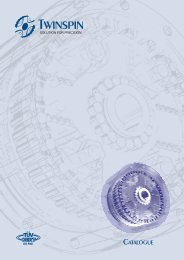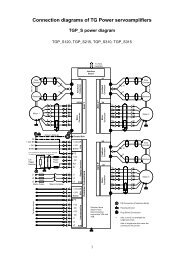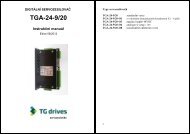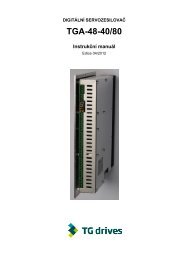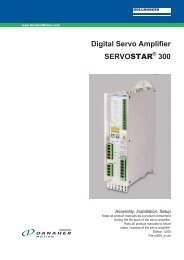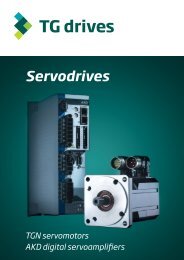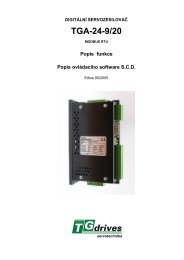Table of Contents - TG Drives
Table of Contents - TG Drives
Table of Contents - TG Drives
Create successful ePaper yourself
Turn your PDF publications into a flip-book with our unique Google optimized e-Paper software.
PL2 MNEMONICS<br />
TRACE RELATED MNEMONICS<br />
Trace Related Mnemonics<br />
Used in combination with SET and GET<br />
instructions to simplify indexing into extended<br />
registers.<br />
Regencode R100,4,5 would give the adress to<br />
the register<br />
Pg.Posspeed.(32768+256*group+member)<br />
The Trace function allows the user to trace the execution <strong>of</strong> the PL program. The<br />
trace will save a time stamp and the current line number where code is executing.<br />
There is room for 512 entries in the buffer. If the PL program is modified<br />
after/during the trace, it will make the trace invalid. To conserve space in the buffer,<br />
the tracing can be limited to interesting parts, by use <strong>of</strong> the Trace OFF/Trace<br />
CONT command or a snapshot that fills the buffer, Trace ONCE. To inspect the<br />
trace buffer content, use the TLIST command. When the Trace is active it slows<br />
down the PL2 rate to about 70 % <strong>of</strong> the normal. That means if Trace is used for<br />
measuring execution speed that has to be compensated for. It also states that<br />
leaving trace active during normal operation is a waste <strong>of</strong> resources!!! To debug an<br />
error situation the Trace can be used like this:<br />
Turn on the Trace function with TRACE ON at the beginning <strong>of</strong> the program. Put<br />
TRACE OFF at the end <strong>of</strong> the error handling routine. When the error occurs there<br />
will be a log <strong>of</strong> the last 512 lines <strong>of</strong> PL2 code that lead up to the error.<br />
Trace ON Initializes the trace buffer and starts trace.<br />
Trace OFF Stops the trace.<br />
Trace CONT Continue trace without initializing the buffer.<br />
Trace ONCE Trace until buffer is full.(Single shot trace)<br />
LAN1/ LAN1 RELATED MNEMONICS<br />
SetObj Lan1 Sval Map the content in MsgObjLan1 to the priority<br />
level specified in Sval.<br />
For a detailed description see the LAN1<br />
group.<br />
GetObj Lan1 Sval Fill in the MsgObjLan1 with the message<br />
object at priority level Sval.<br />
For a detailed description see the LAN1<br />
group.<br />
Read Lan1 Reg, len, level Read len bytes and put in register Reg from<br />
the buffer for message object at level. Where<br />
len and level are Sval.<br />
For a detailed description see the LAN1<br />
group. If len is specified as negative the data<br />
will be byte swapped.<br />
Write Lan1 Reg, len, level Write len bytes to the buffer for message<br />
object at level from register Reg.<br />
For a detailed description see the LAN1<br />
group. If len is specified as negative the data<br />
will be byte swapped.<br />
User's Manual 5.1 Inmotion Technologies AB<br />
Doc. No.9032 0027 01 (B), Rev. 11.07.2001<br />
45



